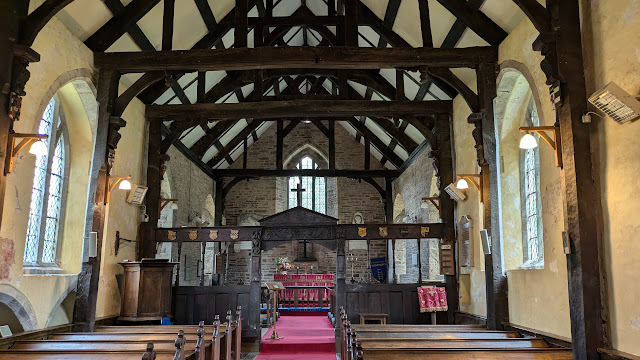We love heritage, especially ruined abbeys and castles and also (usually not ruined) ancient churches and cathedrals. Our short trip to Herefordshire was stuffed full with all sorts of heritage.
We were especially struck by the number of ancient churches in this region. The first we explored was St Margaret's, a Norman church which has a rare example of a rood screen. The screen dates from 1520 and it survived the order of 1547 that all such screens should be removed and destroyed in accordance with the wishes of Henry VIII.
The screen is remarkable in its exquisite carving but must have been even more striking when it was gilded. The screen supports a 'loft' (a gallery): there are only 5 or 6 in the country and St Margaret's is generally thought to be the finest.
As Sir John Betjeman wrote:
‘My own memory of the perfect Herefordshire is a spring day in the foothills of the Black Mountains and finding among the winding hilltop lanes the remote little church of St. Margaret’s where there was no sound but a farm dog’s distant barking. Opening the church door I saw across the whole width of the little chancel a screen and loft all delicately carved and textured pale grey with time.'
Next we went to the village of Vowchurch. Its population is just a couple of hundred but it has two fine medieval parish churches. Legend has it that two sisters had a competition to see who could build the better church. The result is that this village has two of the finest churches in the area, both 12th century.
St Mary Magdalene includes a wooden turret and a fine barrel-roof ceiling. The south door dates from about 1200.
On the opposite bank of the River Dore is St Bartholemews. Also Norman, its chancel screen dates from 1613 and features unusual carvings of Adam and Eve.
The south porch is 17th century although it was rebuilt in 1860.
On our return journey we stopped off at two more noteworthy churches. The first, St John the Evangelist in the village of Shobdon, sits in the grounds of Shobdon Court, demolished in 1933. The church was established in the 14th century but was completely remodelled and partially rebuilt in 1750. The interior was cleared, with some arches being removed and placed elsewhere in the estate an as eye-catcher.
The interior was furnished in a remarkable Rococo style, with everything painted white and blue. The owners of Shobdon Court were acquainted with Horace Walpole and he provided architects from his Committee of Taste, based at Strawberry Hill near Twickenham.
The result is the sole example of the Walpolean Gothick style of Georgian church architecture and furnishing. It looks like it should be in Venice, not a small village in Herefordshire. We had never seen anything like it!
Our final church was at Croft Castle. St John’s church is 14th century, with 17th century box pews and medieval floor tiles.
As we made our way home we reflected on these fine village churches and their huge significance in their communities when they were built, whilst today they do well if they attract two dozen people on a Sunday morning.























